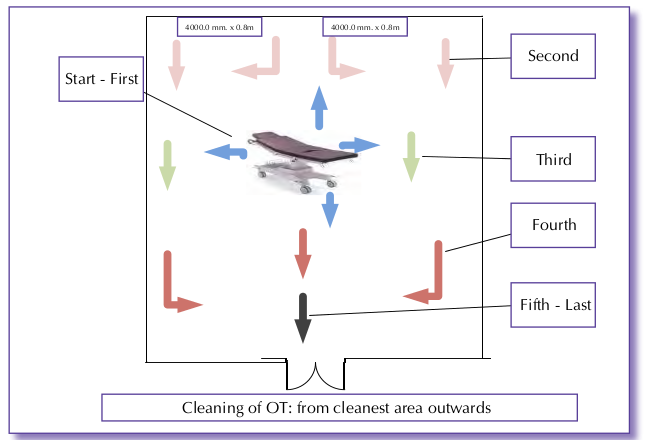Method of cleaning in hospitals
Method of cleaning in hospitals
Different areas require different levels of cleanliness, e.g. the OPD and waiting areas do not require a very high level of cleanliness as compared to that of the Operation theatre or the ICU.
Preparation
- Put gumboots or disposable shoe covers
- Hand-Gloves must always be borne by all personnel engaged in cleaning of Health Facility
- Wear cap, mask, apron / gown
- Follow the manufacturer’s instructions for proper dilution and contact time for cleaning and disinfecting solutions.
- Gather materials required for cleaning before entering the room
- Visibly check and ensure all cleaning equipment itself is clean
- Remove clutter before cleaning
- Move cots and furniture as per the directions of the supervisor to one side.
During Cleaning
- Progress from the least soiled areas to the most soiled areas and from high surfaces to low surfaces.
- Remove gross soil (visible to naked eye) prior to cleaning and disinfection.
- Minimise turbulence to prevent the dispersion of dust that may contain micro-organisms.
- Never shake mops
- Use dust control mop prior to wet/damp mop. Do not use brooms.
- Wash the mop under running water before doing wet mopping .
- Do not ‘double-dip’ mops (dip the mop only once in the cleaning solution, as dipping it multiple times may re contaminate it).
- An area of 120 square feet to be mopped before re-dipping the mop in the solution.
- Cleaning solution to be changed after cleaning an area of 240 square feet (This does not apply to critical areas like OT and ICU).
- Change more frequently in heavily contaminated areas, when visibly soiled and immediately after cleaning blood and body fluid spills.
- Be alert for needles and other sharp objects. Safely handle and dispose sharps into puncture proof container. Report incident to supervisor
- Collect waste, handle plastic bags from the top (do not compress bags with hands)
- Clean hands on leaving the room.
Direction of cleaning



After cleaning
- De-gown carefully, wash and let them dry.
- Remove your cap and mask wash and let them dry.
- Remove the gloves wash and let them dry.
- Wash your hand as per standard procedure
Practical suggestions
- All loose particles and litter should be removed before dealing with any stubborn stains/dirt.
- Use lighter cleaning methods before attempting stronger methods.
- Before any implement or cloth is used, make sure they are clean and dry.
- If possible, use a double bucket system when mopping the floors so that dirty water is not reused while mopping. The first bucket contains clean water while the second bucket is used to squeeze out the water from the dirty mop following which the mop is dipped in the clean water and mopping done.
- The Three bucket system should be ideally practised and that the first bucket contains water with detergent used in the beginning. The mop is then rinsed in the second bucket and dipped in the third bucket which can also contain a disinfectant and the mopping done again.
- Abrasives should be used as a last resort as they can damage the surface.
- Use an agent that is least offensive in smell if alternatives are available.
- When cleaning a surface, be cautious of marring the surroundings area, e.g. finger prints on walls, grazing other articles, etc.
- Use methods that are least inconvenient to patients. Disturbance can be caused by noise or obstacles placed in public areas.
- Be sure that during the process of cleaning areas do not become accident-prone,e.g. wet, slippery floors, etc. If required, cautionary sign can be put.
- Cleaning should be carefully planned to make efficient use of time.
There is often spill of body fluids & mercury in Health Facilities. Such spillage requires careful cleaning and disinfection. Safety precautions are of utmost importance for the staff and visitors.
Sources:
Last Modified : 2/12/2020
© C–DAC.All content appearing on the vikaspedia portal is through collaborative effort of vikaspedia and its partners.We encourage you to use and share the content in a respectful and fair manner. Please leave all source links intact and adhere to applicable copyright and intellectual property guidelines and laws.
RELATED ITEMS
